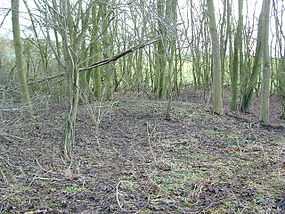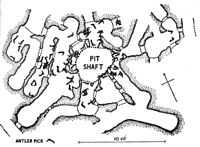William Greenwell
Canon William Greenwell, FRS, FSA, FSA Scot (1820–1918) was an English archaeologist and Church of England priest.
Life
William Greenwell was born 23 March 1820 at the estate known as Greenwell Ford near Lanchester, County Durham, England. He was the eldest son of William Thomas Greenwell (1777–1856) and Dorothy Smales.[1] He had three brothers Francis, Alan, and Henry Nicholas Greenwell, and a sister Dorothy (1821–1882) who published poetry under the name Dora Greenwell.[2] Greenwell died 27 January 1918.
After an early education by Rev George Newby, he attended Durham School. One of his schoolmates was Henry Baker Tristram. He matriculated at University College, Durham in October 1836 and graduated Bachelor of Arts (BA) in June 1839. He started training to be a barrister at Middle Temple, but did not like London and returned to Durham in 1841 to study theology. He received an Master of Arts in 1843.[3] Greenwell was ordained a deacon by Bishop Edward Maltby 30 June 1844 and priest 28 June 1846. He was bursar of University College in Durham from 1844 to 1847.[3]
Archaeology


His family estate included the site of the ancient Roman fort Longovicium. As a child he and his brother Frank would scoop out soil covering the camp, leading to his interest in archaeology. He was a founding member of the Tyneside Naturalists' Field Club in 1846, and later that year toured Germany and Italy. In 1852 he became principal of Neville Hall in Newcastle upon Tyne. In August 1852 he presented a paper at an Archaeological Institute there.[3] In March 1864 he excavated fourteen barrows at Danes Graves a site of the Arras Culture of the British Iron Age and was subsequently criticised by William Harrison-Broadley for his poor excavation technique.[4]:16 Greenwell undertook a large-scale excavation of 53 barrows at Danes Graves with John Robert Mortimer between 1897–98.[4]:17 Greenwell is also noted for his work on the Grimes Graves along with his treatises on electrum coinage of Cyzicus, and cataloguig of the Late Bronze Age finds from Heathery Burn Cave.[5] Greenwell's enormous collection of antiquities, many of which date from the Neolithic or Bronze Age period in Britain, is now in the British Museum.[6] One of his students was Augustus Pitt Rivers.[7]
Career
Greenwell was appointed canon at Durham Cathedral from 1854 to his death, and became known as Canon Greenwell.[8] He was appointed librarian of Durham from 1862 and in 1868 was elected to the Society of Antiquaries of London.[3]
Trivia
He is known as originator of "Greenwell's Glory", used in fly fishing.[9] His fishing and hunting skills developed in early childhood on the River Browney.[3]
Works
- William Greenwell (2006) [1852]. Boldon Buke: a Survey of the Possessions of the See of Durham Made by order of Bishop Hugh Pudsey, in the Year MCLXXXIII. Adamant Media Corporation. ISBN 978-0-543-97277-4. With a translation, an appendix of original documents, and a glossary.
- William Greenwell (1877). British barrows, a record of the examination of sepulchral mounds in various parts of England. the Clarendon press. Together with description of figures of skulls, general remarks on prehistoric crania, and an appendix by George Rolleston.
- William Greenwell (1893). "Rare Greek coins". Numismatic Chronicle, Volume XIII Third Series, Pages 81–92.
- William Greenwell (1897). Durham Cathedral: an address delivered September 24, 1879 (Fifth ed.). Andrews.
- Francis Haverfield; William Greenwell (1899). A catalogue of the sculptured and inscribed stones in the Cathedral Library, Durham. Thomas Caldcleugh for Durham Cathedral Library.
Family tree
| Greenwell family tree | ||||||||||||||||||||||||||||||||||||||||||||||||||||||||||||||||||||||||||||||||||||||||||||||||||||||||||||||||||||||||||||||||||||||||||||||||||||||||||||||||||||||||||||||||||||||||||||||||||||||||||||||||||||||||||||||||||||||||||||||||||||||||||||||||||||||||||||||||||||||||||||||||||||||||||||||||||||||||||||||||||||||||||||||||||||||||||||||||||||||||||||||||||
|---|---|---|---|---|---|---|---|---|---|---|---|---|---|---|---|---|---|---|---|---|---|---|---|---|---|---|---|---|---|---|---|---|---|---|---|---|---|---|---|---|---|---|---|---|---|---|---|---|---|---|---|---|---|---|---|---|---|---|---|---|---|---|---|---|---|---|---|---|---|---|---|---|---|---|---|---|---|---|---|---|---|---|---|---|---|---|---|---|---|---|---|---|---|---|---|---|---|---|---|---|---|---|---|---|---|---|---|---|---|---|---|---|---|---|---|---|---|---|---|---|---|---|---|---|---|---|---|---|---|---|---|---|---|---|---|---|---|---|---|---|---|---|---|---|---|---|---|---|---|---|---|---|---|---|---|---|---|---|---|---|---|---|---|---|---|---|---|---|---|---|---|---|---|---|---|---|---|---|---|---|---|---|---|---|---|---|---|---|---|---|---|---|---|---|---|---|---|---|---|---|---|---|---|---|---|---|---|---|---|---|---|---|---|---|---|---|---|---|---|---|---|---|---|---|---|---|---|---|---|---|---|---|---|---|---|---|---|---|---|---|---|---|---|---|---|---|---|---|---|---|---|---|---|---|---|---|---|---|---|---|---|---|---|---|---|---|---|---|---|---|---|---|---|---|---|---|---|---|---|---|---|---|---|---|---|---|---|---|---|---|---|---|---|---|---|---|---|---|---|---|---|---|---|---|---|---|---|---|---|---|---|---|---|---|---|---|---|---|---|---|---|---|---|---|---|---|---|---|---|---|---|---|---|---|---|---|---|---|---|---|---|---|---|---|---|---|---|---|---|---|---|---|---|---|---|---|---|---|---|---|---|---|---|---|---|---|---|---|---|---|
| ||||||||||||||||||||||||||||||||||||||||||||||||||||||||||||||||||||||||||||||||||||||||||||||||||||||||||||||||||||||||||||||||||||||||||||||||||||||||||||||||||||||||||||||||||||||||||||||||||||||||||||||||||||||||||||||||||||||||||||||||||||||||||||||||||||||||||||||||||||||||||||||||||||||||||||||||||||||||||||||||||||||||||||||||||||||||||||||||||||||||||||||||||
| Notes:
| ||||||||||||||||||||||||||||||||||||||||||||||||||||||||||||||||||||||||||||||||||||||||||||||||||||||||||||||||||||||||||||||||||||||||||||||||||||||||||||||||||||||||||||||||||||||||||||||||||||||||||||||||||||||||||||||||||||||||||||||||||||||||||||||||||||||||||||||||||||||||||||||||||||||||||||||||||||||||||||||||||||||||||||||||||||||||||||||||||||||||||||||||||
See also
- List of archaeologists
- British Iron Age
- British Neolithic
- Grimes Graves
- Arras culture
- Danes Graves
- Durham Cathedral
References
- ↑ Sir Bernard Burke (1871). A genealogical and heraldic dictionary of the landed gentry of Great Britain & Ireland. Volume 1 (5th ed.). Harrison. p. 543.
- ↑ William Dorling (1885). Memoirs of Dora Greenwell. J. Clarke. p. 1.
- ↑ 3.0 3.1 3.2 3.3 3.4 J. T. Fowler. Durham University: Earlier Foundations and Present Colleges (PDF). pp. 150–158.
- ↑ 4.0 4.1 Stead. I. 1979. Arras Culture. Yorkshire Philosophical Society: York
- ↑ Greenwell, W. 1894. “Antiquities of the Bronze Age found in the Heathery Burn Cave, County Durham”, Archaeologia (2nd Series, 4), 87-114
- ↑ British Museum Collection
- ↑ Alison Petch. "Augustus Henry Lane Fox Pitt Rivers and Yorkshire". England: The other within: Analysing the English Collections at the Pitt Rivers Museum. Retrieved 28 March 2010.
- ↑ "Canon Greenwell and the Development of Archaeology in the North of England". Department of Archeology, Durham University. Retrieved 27 March 2010.
- ↑ Andrew N. Herd (2005). "Greenwell's Glory". A Fly Fishing History. Retrieved 27 March 2010.
External links
- The Greenwell Project Homepage (Durham University)
|